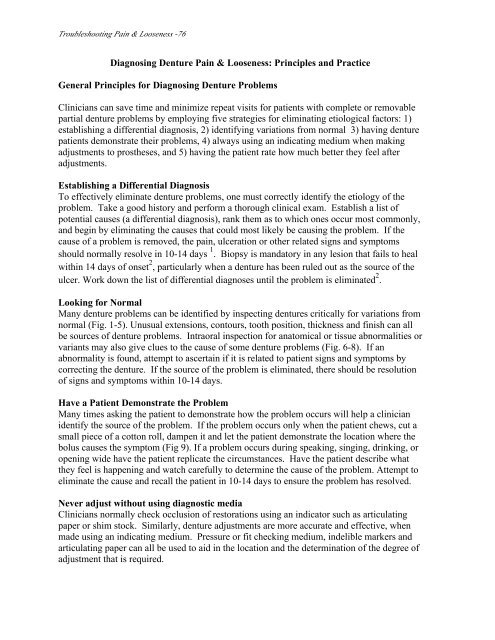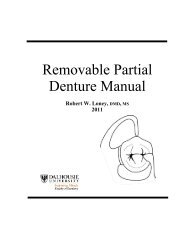Manuals_files/CD Manual 12.pdf - Removable Prosthodontics
Manuals_files/CD Manual 12.pdf - Removable Prosthodontics
Manuals_files/CD Manual 12.pdf - Removable Prosthodontics
Create successful ePaper yourself
Turn your PDF publications into a flip-book with our unique Google optimized e-Paper software.
Troubleshooting Pain & Looseness -76<br />
Diagnosing Denture Pain & Looseness: Principles and Practice<br />
General Principles for Diagnosing Denture Problems<br />
Clinicians can save time and minimize repeat visits for patients with complete or removable<br />
partial denture problems by employing five strategies for eliminating etiological factors: 1)<br />
establishing a differential diagnosis, 2) identifying variations from normal 3) having denture<br />
patients demonstrate their problems, 4) always using an indicating medium when making<br />
adjustments to prostheses, and 5) having the patient rate how much better they feel after<br />
adjustments.<br />
Establishing a Differential Diagnosis<br />
To effectively eliminate denture problems, one must correctly identify the etiology of the<br />
problem. Take a good history and perform a thorough clinical exam. Establish a list of<br />
potential causes (a differential diagnosis), rank them as to which ones occur most commonly,<br />
and begin by eliminating the causes that could most likely be causing the problem. If the<br />
cause of a problem is removed, the pain, ulceration or other related signs and symptoms<br />
should normally resolve in 10-14 days 1 . Biopsy is mandatory in any lesion that fails to heal<br />
within 14 days of onset 2 , particularly when a denture has been ruled out as the source of the<br />
ulcer. Work down the list of differential diagnoses until the problem is eliminated 2 .<br />
Looking for Normal<br />
Many denture problems can be identified by inspecting dentures critically for variations from<br />
normal (Fig. 1-5). Unusual extensions, contours, tooth position, thickness and finish can all<br />
be sources of denture problems. Intraoral inspection for anatomical or tissue abnormalities or<br />
variants may also give clues to the cause of some denture problems (Fig. 6-8). If an<br />
abnormality is found, attempt to ascertain if it is related to patient signs and symptoms by<br />
correcting the denture. If the source of the problem is eliminated, there should be resolution<br />
of signs and symptoms within 10-14 days.<br />
Have a Patient Demonstrate the Problem<br />
Many times asking the patient to demonstrate how the problem occurs will help a clinician<br />
identify the source of the problem. If the problem occurs only when the patient chews, cut a<br />
small piece of a cotton roll, dampen it and let the patient demonstrate the location where the<br />
bolus causes the symptom (Fig 9). If a problem occurs during speaking, singing, drinking, or<br />
opening wide have the patient replicate the circumstances. Have the patient describe what<br />
they feel is happening and watch carefully to determine the cause of the problem. Attempt to<br />
eliminate the cause and recall the patient in 10-14 days to ensure the problem has resolved.<br />
Never adjust without using diagnostic media<br />
Clinicians normally check occlusion of restorations using an indicator such as articulating<br />
paper or shim stock. Similarly, denture adjustments are more accurate and effective, when<br />
made using an indicating medium. Pressure or fit checking medium, indelible markers and<br />
articulating paper can all be used to aid in the location and the determination of the degree of<br />
adjustment that is required.















